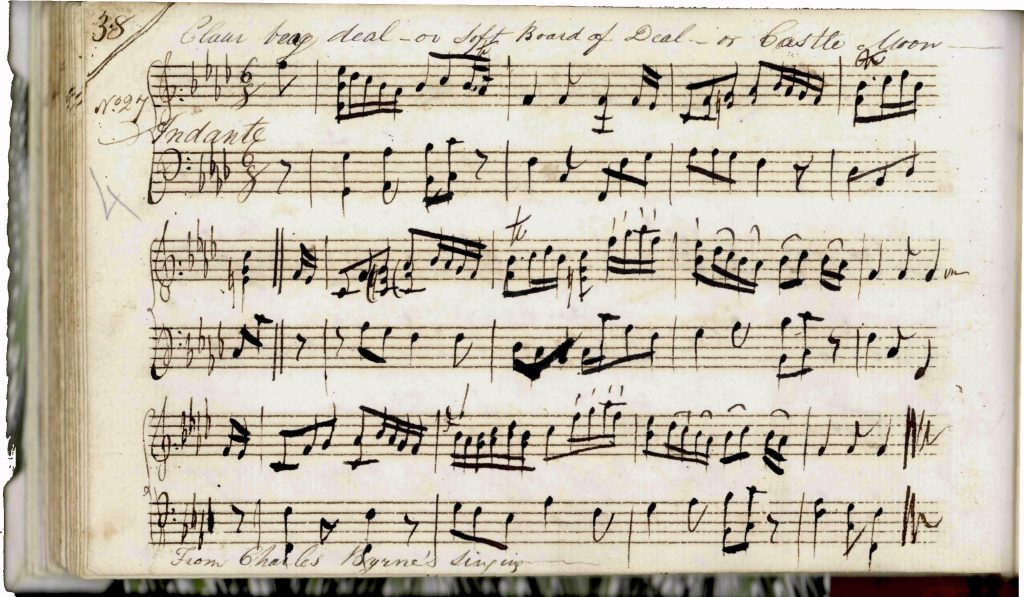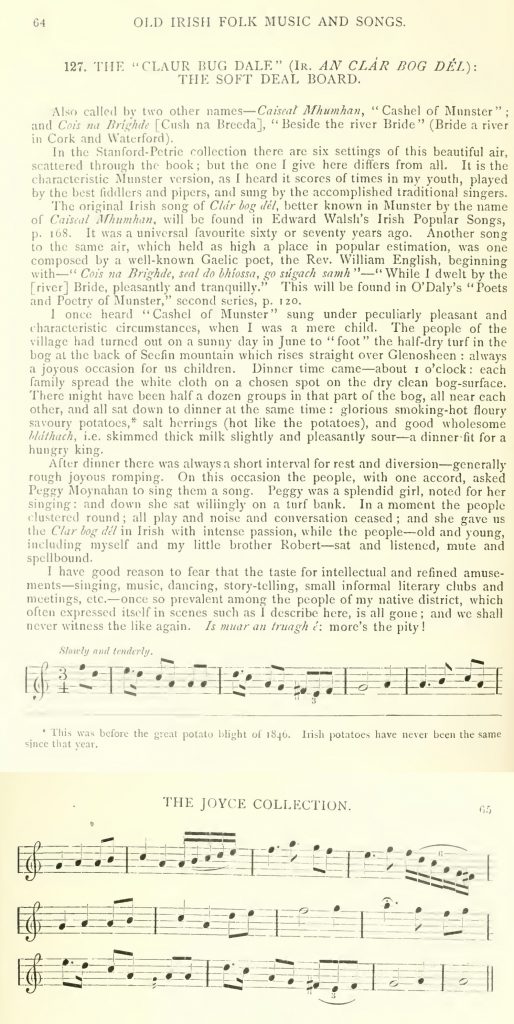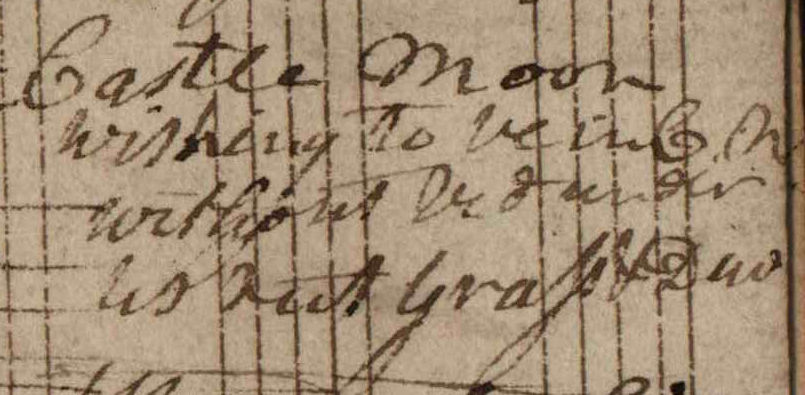The third tune in this group of four we are looking at is on the same page as the Little Munster Mantle. It is titled “Castle Moon” above the notation, and “Cleaur bug deal / soft boards of Deal” below.
This notation looks to me like it was made by Edward Bunting as live transcription “dots” written live as a traditional informant played or sang to him in the 1790s.
The notation is in Queen’s University Belfast, Special Collections, MS4.29 page 93/89/098/f44r.

Although this looks very clear, Bunting (as usual) hasn’t given us a key signature and so we can’t immediately tell if it is in D minor, or D major. I have made two machine audios and PDFs, both showing it in D minor, and I have chosen this partly because his later piano arrangement is in a minor key (see below), and partly also because we recognise characteristic modal runs such as in bars 2 through to 5, A-G-F-D … D-C-A.
The notes of D minor pentatonic are D, F, G, A, C. The B note is an “out of mode note” in D minor, but it still has an effect on the flavour of the tune. My first machine audio uses B♮, and my second uses B♭, because either is plausible. We have information about traditional harp tunings, and we know that B♭ was not a note that was available in the traditional tunings. So if it was played on the harp in this key it would require B natural. But a singer could easily sing it with the B flat.
In my machine audio I have tried to follow all of the written dots. Bunting obviously dotted along following the performance of his traditional informant, and then expanded the dots out with note stems and beams and barlines and bar numbers. He abandoned some of the dots when doing this. He has added a rest in bar 5 but then deleted it – my machine audio plays this rest. He has also put what looks like a double repeat bar symbol in the middle of bar 8, but I think he sometimes uses this symbol as a section divider with no intent to repeat the sections.
You can see that the tune has the less common ABBA structure.
The symbols
I only just noticed that three of our group of four tunes have cryptic symbols at their beginnings. There is not a mystery symbol on A bhean dubh rún dileas on page 92 – perhaps it is not really part of this group?
Beside Little Munster Mantle on page 93, there is a two-barred cross, like this: ‡
Beside our tune, Clár bog déil, on page 93, is a rectangle with lower extensions which I can’t describe better.
Beside Little Hour Before Day on page 94, is a symbol that looks like an equals sign, =
I don’t remember seeing mystery glyphs like this on any other of Bunting’s notations. They remind me a bit of Pádraig Ó Néil’s cypher writing, but I don’t think that is what is going on here. Any suggestions in the comments please…
Bunting’s development of the tune
Bunting made a piano arrangement of this tune in his unpublished Ancient and Modern piano collection which he seems to have compiled in 1798. This two volume set is now kept in Queen’s University Belfast, as MS4.33 parts 3 and 2.

Bunting is clearly working from his live transcription notation in MS4.29 p.93, but he has hugely de-traditionalised the tune to bring it firmly into his classical piano world. This arrangement has a lush chordal accompaniment for the piano, and has been transposed into F minor with four flats.
I think this piano arrangement tells us absolutely nothing about traditional style. What it does tell us is how Bunting understood the title and translation. It also gives us a possible way of understanding the mode, whether the tune is major or minor, though we should recognise that Bunting often played fast and loose with this, pushing things into keys or modes according to his own piano taste rather than respecting the tradition-bearer who gave him the tune.
Because Bunting didn’t publish this or any other piano arrangement, his version of the tune seems to have been pretty much ignored. Donal O’Sullivan only looked at the Bunting tunes that got published, or are related to the published tunes. And later indexes such as Aloys Fleischmann’s, and the different online tune indexes, rely on O’Sullivan for information on tunes from Bunting’s manuscripts.
Attribution to an informant
You can see that Bunting wrote at the bottom of the 1798 piano manuscript “From Charles Byrne’s singing”. I don’t know if he wrote this information into the manuscript in 1798; I have been wondering recently if this writing may have been squeezed in decades later, when we know he was working on attribution information in the late 1830s and early 1840s.
It does make sense though. If Charles Byrne was singing, and this was a vocal version of the tune, it would not be a problem for Byrne to be singing it in D minor with flat Bs. We do know that B♭ was not available in the traditional harp tunings.
We don’t know very much about how the harpers sang, whether or not they always or often self-accompanied on the harp. We have a description of Black singing, and accompanying himself with bass chords (Bunting 1840 intro p.97), but even then we’re not told if the chords were continuous, or just at line-ends for example. I wonder if it might have been more common for the harper to not play while singing, or perhaps to play as an introduction and then stop playing the harp while they actually sung, which is a thing we see in the tradition. Either way, if Byrne did sing this in D minor with a flat 6th, he could have sung completely unaccompanied, or he could have played a D drone or motif which avoided the B♭. We have some descriptions of Charles Byrne, that he was not a good player, but that he sang a lot.
Bunting wrote the title “Castle Moon” (his mis-spelling of Casieal Mumhan) quite a few times in his tune lists in his transcription notebooks, but at this stage I don’t have much understanding of what these tune lists represent. Some of them at least seem to be of tunes connected to particular informants or collecting sessions; others seem to be him assembling lists of tunes perhaps that he thinks might be suitable for publication. Tune lists that include our tune are on page 86 where it is alongside the little hour before day and the Munster mantle. On page 145, our tune is listed, and so too are “hoirs veoge rive r[aa]” (little hour before day) and “Fauilin veoge moinagh” (the Munster mantle), though they are not all together in this list. On page 173 all three tunes are together again. On page 178 our tune is listed with little hour before day. On page 200 is what looks like the beginnings of a great alphabetical index that only runs from A to C, and there our tune is listed without the other two.
On page 178 he wrote a tune list where most of the titles are tagged “Daniel Black”. The title of “Castle Moon” and also the title of “Little hour before day” are both on this list. suppose it is possible that we could understand this list as implying that Black was the source for all of these transcriptions in the group we are looking at on pages 92 to 94. But we also have to remember that much of the repertory was likely common to many of the old harpers, and that just because Bunting tells us that a certain harper played him a certain tune, does not mean that a particular transcription notation was made live from the playing of that particular harper.
Other versions of the tune
I note that Mary McCracken wrote a tune titled “Claur Bog Deal” into her music book c.1808, which is now in with Bunting’s manuscripts (see Moloney, Introduction & catalogue 2000 p.288). But I have not seen this.
There seem to be quite a few variants of the lyrics and tune. Joyce, Old Irish folk music and song no.127 p.64 gives a tune, with a lovely story of how he remembered hearing it sung when he was young.

Joyce also says that Stanford-Petrie contains “six settings… scattered throughout the book”. I have spotted five of these: On page 147 is no.581 “The soft Deal Board / From Father Walsh”, and also no.582 “The soft deal bed / A Munster air”. On pages 295-6 we have no.1167 “Cois na bríghde / as set by Dr Hudson at Clonnkilty – and given to Forde”, no.1168 (title illegible in my copy), and no.1169 “Cois na Bríghde”. I’m sure there are many more we could find and compare if we wanted to.
Title
Bunting had no (or very little) Irish so we understand him writing phonetically “Castle Moon” for “Caiseal Mumhan”, and “Cleaur bug deal” for “Clár bog déil”. By 1798 when he was making his piano arrangement he had either got a little Irish, or consulted someone who did, and he gives the title as “Claur beag Deal”. Bunting or his assistant seems to have misunderstood “bog” (soft) as “beag” (little).
“Clár bog déil” is the usual title now; it means “soft boards of deal”. Some people now understand the word “bog” to be the English word “bog” (a marsh or wetland) rather than the Irish word “bog” (soft). “Déil” is the ordinary Irish word for deal timber.
The other title, “Caiseal Mumhan” is an older or more unusual version of the place name of Cashel in county Tipperary. “Caiseal” is a fortress, and “Mumhan” means “of Munster”, so this name refers to Cashel’s former status as the Royal capital of Munster.
Both of these phrases, “clár bog déil” and “Caiseal Mumhan”, appear in the words of some versions of the song.
Song
In the tune list on MS4.29 page 86, Bunting wrote down a fragment of the words of the song in English, under the title Castle Moon:
Wishing to be in C M
without [bed] under
us [but] grass & [Dew]
I can’t really read the words in square brackets, they are my best guesses.
These words look like they might be a paraphrase or loose translation of part of the traditional lyrics as still sung today. The song of Clár Bog Déil is well known in the tradition, and is a man’s song where he is sad that he can’t be with his true love, and that he would be willing to marry her without a dowry or any way to provide for them, and that they could just lie together on the ground or on the soft wooden planks. You can get some lyrics at Mudcat.
There is a song by William English (c.1695-1778), called “Cois na Bríde”, which is specified to be sung to the tune of “Clár bog Déil”. The second verse of English’s lyrics is the same as what the traditional singers sing, including the lines including the lines “‘s e mo ghalar dubhach gan mé is tú, a grá mo chléibh / i gCaiseal Mumhan ‘s gan de leaba fúinn ach clár bog déil” (I’m sad that we aren’t together my love, in Cashel, without a bed except for the soft deal board), but his other verses seem different. Perhaps he composed a new song to the old tune, and incorporated the key verse into his poem. See Úna Nic Éinrí, Canfar an Dán (2003) p.152 and CD track 9 for a text and a sung performance by Pádraig Ó Cearbhaill, based on the Joyce tune I think, or at least very close to it. There is an ITMA video of Ó Cearbhall singing this version as well.
Patrick Lynch got three verses under the title “Clár bog déil” when he was collecting song texts in Mayo in 1802. You can see his text at QUB SC MS4.26.19s, and his facing page English translation on MS4.26.19r:
Ta starraigh do chailin beag óg am chradh
Ina bhuil las iona leacan agus rós na lar
Dfaig me an airtiogal broin is bais
Is do bhuain si mo thathigh go deoigh do mhnaith
Ta uir-phíb ag am mhoirnin ‘sa braghaid mar an aol
‘sa cuilin deas buidhchasta fas go fear
da bhfaighinn cead a ccomhaltaibh sa maithrin fein
do phosuinse mo mhoirnin gan feoirlin spre
San oidche nuair smuaineam tre lár mo shuain
go bhuilimse is an righbhean a bportlairge an chuain
Sínte le na ciach chruinne baine suas
Acht faraoir gear nach lear dhumh acht sgaile fuar
a sprightly young girl distresses me
her cheeks blushing with the rose in the centre
she has left me in the grievous pangs of death
she taken away my affection for all other women
My Charmers neck it is fair, and her breasts like lime
Her lovely locks behind in yellow ringlets growing to the grass
If I had the consent of her friends and her own <little> mother
I would marry my beloved without a farthing of dowry
At night imagine in the midst of my dreams
That I and my queen at the coast of Port Lairge
And stretched up by her white round breasts
But alas my sharp grief when I find but empty shadow
Lynch also made a neat presentation copy at QUB SC MS4.10.053, which is very similar to this text but with a few different words or spellings. I don’t know who Lynch got these words from, and as usual he gives us no clue what tune they were sung to. This version of the lyrics doesn’t include the line about Caiseal Mumhan or clár bog déil; instead it uses the place name Port Láirge (Waterford). Another copy of this text in Irish with facing page Latin translation was written down by Richard MacElligott, and can be seen online at QUB SC MS4.26.42b (Irish) and MS4.26.42c (Latin). There are a couple of other English translations of these same three verses in Bunting’s papers.
There are a lot of versions sung today. Here’s a couple of example performances of traditional versions of the song which I found on Youtube:
Máire Ní Cheileachar’s youtube includes the text of her words on the video description page.
Séamus Ennis’s tune seems not too far away from our version.
Many thanks to Queen’s University Belfast Special Collections for the digitised pages from MS4 (the Bunting Collection), and for letting me use them here.
Many thanks to the Arts Council of Northern Ireland for helping to provide the equipment used for these posts, and also for supporting the writing of these blog posts.



Thanks, Simon, for this excellent discussion.